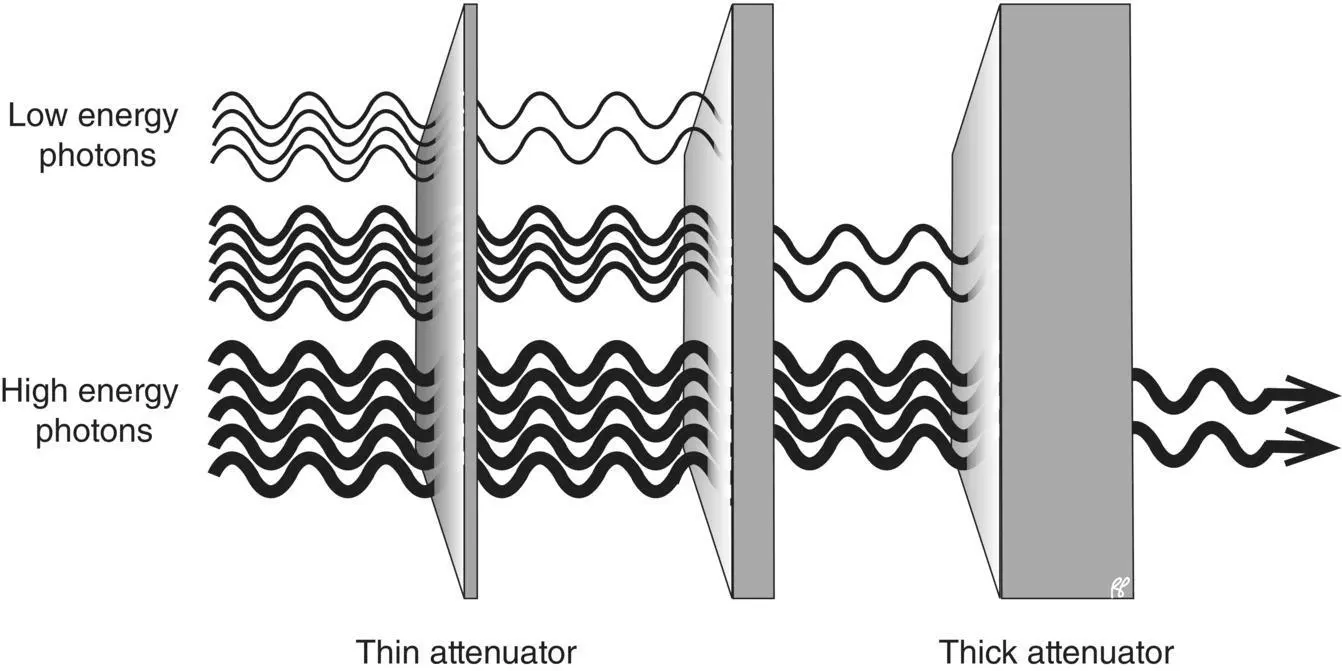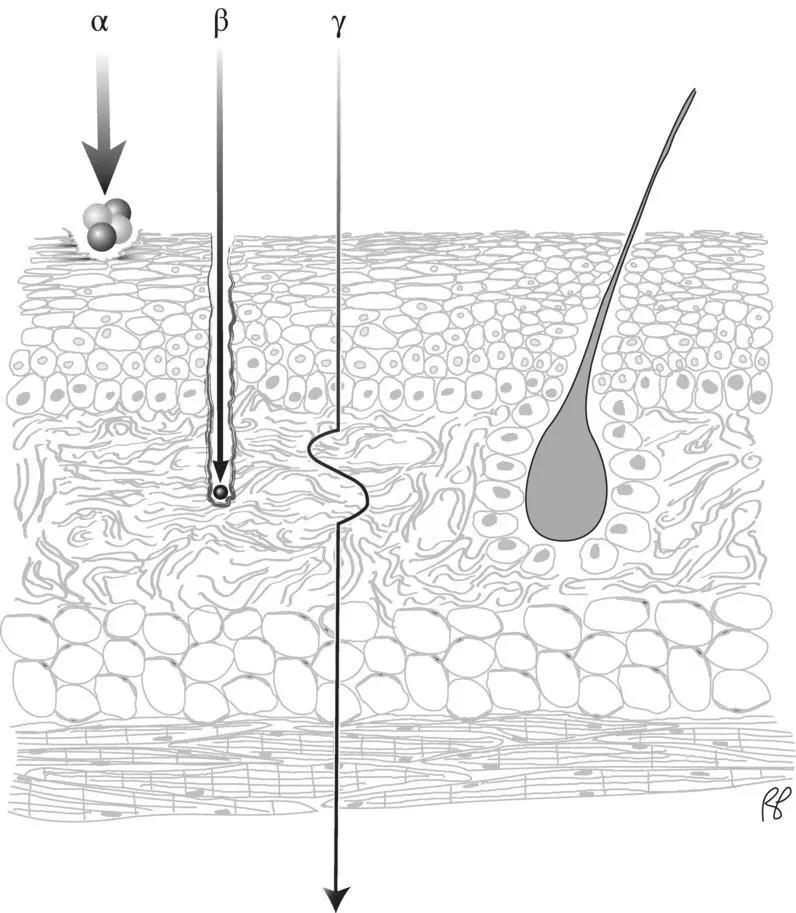
Figure 2.3 Angle of photon scattering.

Figure 2.4 Photoelectric effect.
A separate term, the mass attenuation coefficient( μ/ρ ), is the linear attenuation coefficient divided by the density of the attenuator. When the density of a material is given in grams/cm 3the units of the mass attenuation coefficient are cm 2/gram.
Absorptionof radiation describes another aspect of the process of attenuation. Attenuation describes the weakening of the beam as it passes through matter. Absorption describes the transfer of energy from the beam to the matter.
Half‐value and tenth‐value layers
A material’s effectiveness as a photon attenuator is described by the attenuation coefficient. An alternative descriptor, one that is the more easily visualized, is the “half‐value layer” ( HVL) which is simply the thickness of a slab of the attenuator that will remove exactly one half of the radiation of a beam. A second slab of the same thickness will remove half of the remainder (see comment below regarding monoenergetic beams), leaving one quarter of the original beam, and so forth. For a gamma photon of 100 keV, the HVL in soft tissue is about 4 cm [1].
Table 2.1 Predominant photon interactions in common materials at diagnostic energies
| Material |
Atomic number (Z) |
Density (gm/cm3) |
Predominant interaction |
| H 2O |
7.4 |
1.0 |
Compton scatter |
| Soft tissue |
7.5 |
1.0 |
Compton scatter |
| Glass (silicon) |
14 |
2.6 |
Compton scatter |
| O 2(gas) |
16 |
0.0014 |
Compton scatter |
| NaI (crystal) |
32 |
3.7 |
Photoelectric effect |
| Lead |
82 |
11.4 |
Photoelectric effect |
| Leaded glass |
14, 82 |
4.8–6.2 |
Photoelectric effect |
For any attenuator the HVL can be determined experimentally using a photon source and a suitable detector. For calculations involving attenuation of high‐intensity radiation beams, an entirely similar concept, the tenth‐value layer ( TVL), is useful. The TVL is the thickness of the attenuator that will transmit only one tenth of the photons in the beam. For a monoenergetic beam (containing photons of identical energies) directed at a material, two such thicknesses will transmit only one hundredth of the beam. If, however, the beam contains photons of different energies this rule is not applicable (see text box on beam hardening).

Figure 2.5 Attenuation.
Table 2.2lists half and tenth value layer of lead for photons emitted by some common medical radionuclides.
For a monoenergetic beam of photons, the linear attenuation coefficient, μ , is related to the HVL as follows:

When a beam contains photons of different energies such as an X‐ray beam, it is termed polychromatic.As a polychromatic beam penetrates a material, lower energy photons are extinguished or scattered preferentially over higher energy photons and the result is that, while the overall intensity is diminished, the average energy of the transmitted fraction of the beam is increased. This phenomenon is known as beam hardening. A hardened beam is more penetrating and so a second HVL or TVL will be slightly thicker than the first.

Figure 2.6 The amount of attenuation of a photon beam is dependent on the photon energy and the thickness (and/or atomic number) of the attenuator.
Table 2.2 HVL and TVL of lead for photons of common medical nuclides
| Nuclide |
Gamma energy (keV) |
Half‐value layer (cm) |
Tenth‐value layer (cm) |
| 99mTc |
140 |
0.03 |
0.09 |
| 67Ga |
93, 185, 300, 393 |
0.07 |
0.41 |
| 123I |
159 |
0.04 |
0.12 |
| 131I |
364 |
0.3 |
1 |
| 18F |
511 |
0.39 |
1.3 |
| 111In |
172, 245 |
0.023 |
0.2 |

Figure 2.7 Penetrating radiation and nonpenetrating radiation.
The term penetrating radiationmay be used to describe X‐ray and gamma radiation, as they have the potential to penetrate considerable thickness of a material. Although we have just described some of the many ways photons interact with matter, the likelihood of any of these interactions occurring over a short distance is small. An individual photon may travel several centimeters or farther into tissue before it interacts. In contrast, charged particles (alpha, beta) undergo many closely spaced interactions. This sharply limits their penetration ( Figure 2.7).
Interaction of charged particles with matter
Because of the strong electrical force between a charged particle and the atoms of an absorber, charged particles can be stopped by matter with relative ease. Compared to photons, they transfer a greater amount of energy in a shorter distance and come to rest more rapidly. For this reason, they are referred to as nonpenetrating radiation(see depiction of alpha and beta particles in Figure 2.7). In contrast to a photon of 100 keV which has a HVL of 4 cm in soft tissue, an electron of this energy would penetrate less than 0.00014 cm in soft tissue [1].
Charged particles (alphas, betas, and positrons) interact with the electrons surrounding the atom’s nucleus by transferring some of their kinetic energy to the electrons. The energy transferred from a low‐energy particle is often only sufficient to bump an electron from an inner to an outer shell of the atom. This process is called excitation. Following excitation, the displaced electron promptly returns to the lower‐energy shell, releasing its recently acquired energy as an X‐ray in a process called de‐excitation ( Figure 2.8). Because the acquired energy is equal to the difference in binding energies of the electron shells and the binding energies of the electron shells are determined by the atomic structure of the element, the X‐ray is referred to as a characteristic X‐ray.
Charged particles of sufficient energy may also transfer enough energy to an electron (generally one in an outer shell) to eject the electron from the atom. This process is called ionization( Figure 2.9). This hole in the outer shell is rapidly filled with an unbound electron. If an inner shell electron is ionized (a much less frequent occurrence) an outer shell electron will “drop” into the inner shell hole and a characteristic X‐ray will be emitted. Ionization is not limited to the interaction of charged particles and matter, the photoelectric effect and Compton interactions are examples of photon interactions with matter that produce ionization.
Читать дальше


















